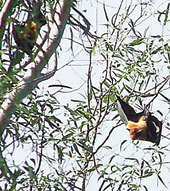 |
Morning strollers did not take notice of the new guests. Most are either scared of bats or understand little about the species. Bats are the only mammals with unique ability of powered flight.
Zoologists have classified these winged creatures in order ? Chiroptera, Greek for ?hand wings?. Bats do not have wings in the real sense, they have ?patagium?, double membranes stretching between forelegs, fingers and the body.
Around a thousand species of bats around the world, all nocturnal, roost by hanging upside down on the branches with their clawed feet when the sun is up. On the basis of their food habits, these mammals have been broadly classified into two categories ? Megabats (fruit-eaters) and Microbats (insect-eaters].
Microbats navigate by echo location, emitting ultrasound (inaudible to human ear) and then ?reading? the waves as they bounce back from the obstacles to the bat?s highly sensitive ear receptors. Megabats, on the other hand, use their sharp sight and acute sense of smell. They are also called Flying foxes due to their fox-like snout. The average lifespan of flying foxes are 15 years. The largest bat in the world is a flying fox called Kalong, which has wings spread upto five feet.
Unlike other warm-blooded mammals, bats maintain a warm body temperature. Only when they are active or asleep their body temperature drops to the temperature of the air around them. If the surroundings are cold enough, the bat enters a state called Torpor.
In this state of suspended animation, energy is conserved because of the drop in biological activity within the bat. Bats need more water than other mammals of similar size as they lose a lot of moisture through their ?wings? in active state. Flying foxes are adept at swimming and manage to cross rivers using their ?wings? as flippers.
The Morabadian guests are one of the three common Indian Flying foxes named Rousettus leschenauli ? a fulvous fruit bat with a dull, yellow body colour.
Flying foxes play a pivotal role on multifarious ecosystems. They act as seed-dispersal agents as they feed on small Eucalyptus flowers, mangoes, guavas and other fruits. They assist pollination and of more than 114 species of plants which are of economical, ecological, medicinal and even religious importance. Wild varieties of bananas and guavas are dependent on bats to maintain their population.
Despite playing such an important role in the natural cycle, bats are deprived of any kind of official protection in Jharkhand. Flying foxes are brutally netted out and killed for meat by some tribes in this area. Their number is also affected by regular use of pesticides by farmers to protect their orchards from these Flying foxes.
About 12 fruit bats have been classified as ?vermin? under the Wildlife Protection Act. No monitoring of their population has been done in the near past, thus little is known about their actual status.
Yet, without a thorough documentation of their ecological value, it is difficult to convince government for their protection. Researchers and students can hardly guess whether these new guests tend to prolong their stay or the Eucalyptus would rather see them off soon.
Bandana and Sudhanshu
P.P.K. College, Bundu











